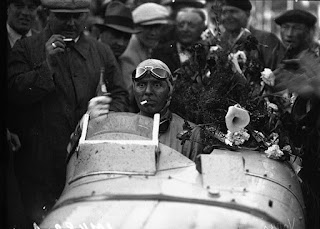Flavio Insinna - actor and presenter
Star of TV dramas turned game show host
The actor and presenter Flavio Insinna, who is the host of Italy’s popular television game show L’eridità and was formerly the face of Affari tuoi - the Italian version of Deal or No Deal - was born on this day in 1965 in Rome. In a broad-ranging career, Insinna has run up an impressive list of credits in cinema, theatre and television as well as publishing an autobiography and a novel. He is also known for his philanthropy after donating his 49-foot boat Roxana to humanitarian organisation Médecins Sans Frontières to help rescue Syrian refugees. In a substantial catalogue of television drama and comedy appearances, notable was Insinna’s portrayal of the Carabinieri captain Flavio Anceschi in the popular Rai Uno series Don Matteo, with Terence Hill and Nino Frassica. Ironically, Insinna’s ambition after obtaining his Liceo Classico diploma from Rome’s Augusto high school in 1984, had been to become a Carabinieri officer but after failing to gain admission to the elite police force’s training college he opted for acting. He enrolled at the drama school run by the Polish-Italian dramatist Alessandro Fersen and later joined the drama laboratory led by the Rome-born singer and actor Gigi Proietti, who had been one of his heroes growing up. Read more…
____________________________________
Ulisse Stacchini - architect
Designer behind two famous Milan landmarks
Ulisse Stacchini, the architect who designed two of Milan's most famous 20th century landmarks, was born on this day in 1871 in Florence. A champion of Liberty-style Art Nouveau designs, Stacchini's defining work was the gargantuan Stazione di Milano Centrale - the city's main railway terminal. He also designed the stadium that evolved into the city's iconic Stadio Giuseppe Meazza, joint home of Milan's two major football clubs, Internazionale and AC Milan. Stacchini studied in Rome and moved to Milan soon after graduating, setting up a partnership with the engineer Giulio de Capitani, building houses, offices and shops for private clients. Among his early projects was the Savini Caffè in the Galleria Vittorio Emanuele II. His style can be seen in a number of town houses commissioned by wealthy patrons, including Via Gioberti 1 at Via Revere 7, which feature linear designs. He became involved with the Milano Centrale project when he won a design competition in 1912, although construction was delayed by more than a decade because of the crisis in the Italian economy that followed the First World War. Read more…
____________________________________
Alessandro Blasetti - film director
Reputation tarnished by links with Mussolini
Alessandro Blasetti, the film director sometimes referred to as ‘the father of Italian cinema’ for the part he played in reviving the film industry in Italy in the late 1920s and 30s, was born on this day in 1900 in Rome. In his directing style, Blasetti was seen as ahead of his time, even in his early days. His films were often shot on location, used many non-professional actors and had the characteristics of the neorealism that would make Italian cinema famous in the post-War years. Yet he will forever be seen by some critics as an apologist for Fascism, a charge which stems mainly from his support for at least part of the ideology of Benito Mussolini, which led to a number of his films being interpreted as Fascist propaganda, although the evidence in some cases was rather thin. The son of an oboe professor at Rome’s Accademia Nazionale di Santa Cecilia, Blasetti graduated in law from the Sapienza University of Rome. Married in 1923, his first job was as a bank clerk but after a year he began to work as a journalist and wrote the first film column to appear in an Italian national newspaper. He used his position to campaign for a revival of film production in Italy. Read more…
_____________________________________
Walter Veltroni - politician
Popular former communist twice elected Mayor of Rome
The politician Walter Veltroni, who was the first leader of Italy’s centre-left Democratic Party (Partito Democratico) and was twice elected Mayor of Rome, was born on this day in 1955 in Rome. A popular figure, Veltroni helped the PD reach a level of influence in Italian politics that enabled them to provide the leaders of three consecutive governments in Enrico Letta, Matteo Renzi and Paolo Gentiloni before the centre-left were routed at the 2018 general election. Veltroni had such charisma and broad appeal that he was often tipped as a future prime minister, but his star began to wane after he lost the April 2008 general election in a head-to-head with Silvio Berlusconi’s centre-right People of Freedom party. He had stepped down as Mayor of Rome in order to focus on winning the election so defeat was a crushing blow. In February 2009, following a heavy defeat for PD in regional elections in Sardinia and amid clashes within the party, he resigned as leader, giving way to his former deputy, Dario Franceschini. Veltroni's political career had begun in 1976, when he was elected as a Rome city councillor as a member of the Italian Communist Party (PCI). Read more…

.jpg)

.jpg)

.jpg)

.jpeg)




_(cropped).jpg)

.jpg)
.jpg)
